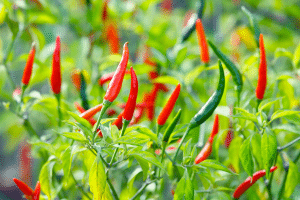
Soil and Planting
Our peppers grow in a warm, sunny location with adequate moisture and well-drained soil, generally under cover (such as the greenhouse). This includes hot peppers and sweet peppers; bell peppers and hot peppers; yellow, red, and green peppers; and everything in between!
To ensure that our peppers grow tall and produce fruit in time for harvest, we begin growing peppers during the earliest season. We make certain that the pepper seeds are first sown in a topsoil mix and then placed approximately ¼ inch into the ground. We also keep the pepper plant seedlings near a heat source since a higher soil temperature fosters their growth.
The next step of the growing peppers process involves transplanting the pepper seedlings into a larger space in moist, peat-free, multi-purpose compost. We do this as soon as they are big enough to avoid causing harm to the young plants. They are generally transplanted in May or December, depends on the location, with a minimum distance of 18 to 36 inches between them.
It is noteworthy that the longest growing period is observed in the hottest chili pepper plants. Hence, when we plant peppers, we start at least 6 to 8 weeks before the average final frost date for our region.
Caring
We never cut corners when it comes to caring for our plants and producing the best quality product. We take good care of them by providing ample lighting for their needs while they’re still in evenly moist soil so none of the pepper plants wilt or droop over time.
Our team of growers starts pinching out the tips of plants that are approximately 20 cm tall to promote bushy development. Staking is employed for high-growing kinds. We also feed the young plant once a week with a high potash liquid fertilizer when the first flowers appear. In the summer, we spray the plants with water to increase humidity and prevent red spider mites. We do everything we can to guarantee that our young pepper plants are in tip-top shape, so you get the best and fieriest chili possible.
Troubleshooting
Although peppers are robust and appear to have few severe pests and disease issues, we remain on the lookout for any infected plant among the plants. We do this in addition to growing more resilient cultivars.
We keep an eye out for plants that appear to be weak and stringy since they may be infested with viruses, which are spread by aphids and other tiny insects. We’ll remove heavily infected plants from our crops to avoid them from spreading the infection to the remaining crops.
Finally, covering the plants once we’ve received a forecast of frost in the region is another method we employ to defend against disease spreading through our crops.
Harvesting Pepper Plants
At Magic Plant Farms, we handpick all of our chilies and bring them in to be sorted and processed the same day. This ensures that our chilies are as fresh as possible when they reach your kitchen.
We prefer to wait until they become brighter in color and have a more robust flavor and hotter taste before harvesting peppers. The peppers are then cleaned, de-seeded, and dried.
